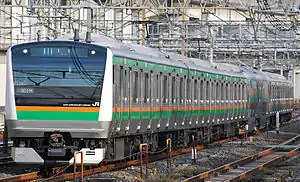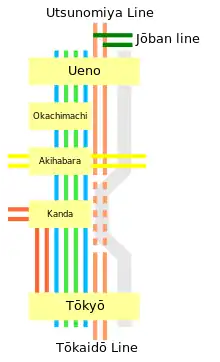| Ueno–Tokyo Line | |
|---|---|
 An E233-3000 series EMU, one of the train types used on the Ueno–Tokyo Line | |
| Overview | |
| Native name | 上野東京ライン |
| Status | Operational |
| Locale | Tokyo |
| Service | |
| Type | Commuter rail |
| Operator(s) | |
| Daily ridership | 320,229 (daily, 2015)[1] |
| History | |
| Opened | 14 March 2015 |
| Technical | |
| Track gauge | 1,067 mm (3 ft 6 in) |
| Electrification | 1,500 V DC overhead catenary |
The Ueno–Tokyo Line (Japanese: 上野東京ライン, romanized: Ueno–Tōkyō Rain), formerly known as the Tōhoku Through Line (Japanese: 東北縦貫線, romanized: Tōhoku-Jūkan-sen)[2] is a railway line in Tokyo, Japan, operated by the East Japan Railway Company (JR East), linking Ueno Station and Tokyo Station, extending the services of the Utsunomiya Line, the Takasaki Line, and the Jōban Line southward and onto the Tōkaidō Main Line[2][3] and vice versa. The project began in May 2008.[4] The line opened with the 14 March 2015 timetable revision,[5] with the project costing about JPY 40 billion.[2]
Direct travel was expected to ease congestion on the Yamanote Line and Keihin–Tōhoku Line, and the travel time was reduced to 7 to 10 minutes because of through trains between the lines of Utsunomiya and Takasaki and the Main Line of Tokaido in addition to through trains that pass the Shinagawa Station on the Joban Line.[4]
Route

Beginning from Ueno Station, the project involved re-laying about 2.5 km (1.6 mi)[4] of existing tracks that formerly linked the two stations until separated near Kanda Station to make room for the Tōhoku Shinkansen extension to Tokyo. The gap was reconnected by a new 1.3 km (0.81 mi)[4] top deck on the existing Shinkansen viaduct near Kanda Station with ramps at either end up from the existing formations.[6] Provision was made during construction of the Shinkansen link for eventual restoration of through traffic on the Tohoku Lines.[7] JR East built train turnback facilities at Shinagawa Station on the Tōkaidō Line, allowing through trains from Ueno to terminate there and return north.[2]
Services
Trains from the Utsunomiya Line, Takasaki Line, and Jōban Line run non-stop between Ueno and Tokyo Station and continue on the Tōkaidō Line towards Shinagawa (all trains departing the Jōban Line terminate here), Yokohama,[8] Ōfuna, Hiratsuka, Kōzu, Odawara, Atami, Numazu in the JR Central Tōkaidō Main Line and Itō in the Itō Line. Initially, up to 15 services per hour run during the morning peak, increased to 20 per hour in 2016.[9] Joban Line limited express services (Hitachi limited-stop and Tokiwa semi-fast) were extended south of Ueno via the Ueno–Tokyo Line, with most services terminating at Shinagawa Station.[10]
History
The Tōhoku Main Line ran to Tokyo station both prior to and following World War II. Although the connector between Ueno and Tokyo was only used for freight trains and forwarding at first, the Allied occupation forces ran passenger trains from Tokyo Station through the Tohoku Main Line following World War II, and this was followed by a number of through services from the 1950s until the 1970s. The connection between Ueno and Tokyo was closed to passenger service in April 1973, and to freight service in January 1983; the portion of the line around Akihabara and Kanda was dismantled to provide a right-of-way to extend the Tōhoku Shinkansen to Tokyo Station, with through services to Tokyo station commencing in 1991.
A government panel recommendation in 2000 suggested restoring the connector between Ueno and Tokyo by 2015, and JR East officially announced the project on 27 March 2002.
The project received support from various local governments, particularly in Saitama Prefecture, Ibaraki Prefecture, and other areas to the north of Tokyo. However, residents of the area immediately surrounding the project cited light blockage and earthquake risk, and applied to a Tokyo court for an injunction against construction in 2007.[11] The lawsuit was dismissed in 2012.
The project was originally scheduled to be completed in fiscal 2013, but completion was delayed by the effects of the 2011 Tōhoku earthquake and tsunami.[9]
 View of the planned route south of Akihabara Station in March 2007
View of the planned route south of Akihabara Station in March 2007 View from the platform of Kanda Station, October 2009. A bridge pylon is being built to carry a viaduct of the future Ueno–Tokyo Line. A ramp structure can be seen in the background.
View from the platform of Kanda Station, October 2009. A bridge pylon is being built to carry a viaduct of the future Ueno–Tokyo Line. A ramp structure can be seen in the background. Sign at Sanuki Station on the Jōban Line promoting the early completion of the project. The headline reads Without transfer, to Tokyo Station, to the Shinkansen
Sign at Sanuki Station on the Jōban Line promoting the early completion of the project. The headline reads Without transfer, to Tokyo Station, to the Shinkansen Elevated section of the Ueno–Tokyo Line under construction over the Tohoku Shinkansen tracks in August 2011
Elevated section of the Ueno–Tokyo Line under construction over the Tohoku Shinkansen tracks in August 2011
Station list
| Official Line Name | No. | Station | Japanese | Distance (km) | Utsunomiya/Takasaki–Tōkaidō | Jōban Line | Transfers | Locations | ||||
|---|---|---|---|---|---|---|---|---|---|---|---|---|
| Between stations | From Tokyo | |||||||||||
| Within the Utsunomiya and Takasaki lines (through service): | Local | Rapid Rabbit • Urban |
||||||||||
| Tōhoku Main Line | OMYJU07 |
Ōmiya | 大宮 | - | 30.5 | ● | ● |
|
Ōmiya Ward | Saitama City | Saitama Prefecture | |
| JU06 | Saitama-Shintoshin | さいたま新都心 | 1.6 | 28.9 | ● | | |
| |||||
URWJU05 |
Urawa | 浦和 | 4.5 | 24.4 | ● | ● |
|
Urawa Ward | ||||
ABNJU04 |
Akabane | 赤羽 | 11.0 | 13.4 | ● | ● |
|
Kita City | Tokyo | |||
| JU03 | Oku | 尾久 | 5.0 | 8.4 | ● | | | ||||||
NPRJJ02 |
Nippori | 日暮里 | 2.6 | 5.8 | | | | | ● |
|
Arakawa City | |||
| UENJU02JJ01 | Ueno | 上野 | 2.2 | 3.6 | ● | ● | ● |
|
Taitō City | |||
| TYOJT01JU01 | Tokyo | 東京 | 3.6 | 0.0 | ● | ● | ● |
|
Chiyoda City | |||
| Tōkaidō Main Line | ||||||||||||
SMBJT02 |
Shimbashi | 新橋 | 1.9 | 1.9 | ● | ● | ● |
|
Minato City | |||
SGWJT03 |
Shinagawa | 品川 | 4.9 | 6.8 | ● | ● | ● |
| ||||
KWSJT04 |
Kawasaki | 川崎 | 11.4 | 18.2 | ● | ● |
|
Kawasaki Ward | Kawasaki City | Kanagawa Prefecture | ||
YHMJT05 |
Yokohama | 横浜 | 10.6 | 28.8 | ● | ● |
|
Nishi Ward | Yokohama City | |||
TTKJT06 |
Totsuka | 戸塚 | 12.1 | 40.9 | ● | ● |
|
Totsuka Ward | ||||
OFNJT07 |
Ōfuna | 大船 | 5.6 | 46.5 | ● | ● |
|
Kamakura City | ||||
| Within the Tōkaidō line (through service): | Local | Local | ||||||||||
Future developments
In January 2014, JR East president Tetsuro Tomita indicated that the company was considering the possibility of linking the Ueno–Tokyo Line in the future with a new direct access line to Haneda Airport also under consideration.[12] Although there had been discussion of completing this extension prior to the 2020 Olympics, the line is currently set to start construction in 2022 for completion in 2029.[13]
See also
- Shōnan–Shinjuku Line, a similar line on the west side of Tokyo
References
- ↑ "平成27年 大都市交通センサス 首都圏報告書" (PDF). P.92. 国土交通省.
- 1 2 3 4 JR East Annual Report 2010, retrieved 2013-12-09
- ↑ 東北縦貫線の開業時期、愛称について [Details of Tōhoku Through Line opening schedule and nickname] (PDF). News release (in Japanese). Japan: East Japan Railway Company. 9 December 2013. Retrieved 9 December 2013.
- 1 2 3 4 "Construction of Ueno-Tokyo Line" (PDF). JR East Construction Department. October 2015. Retrieved 27 November 2019.
- ↑ 「上野東京ライン」2015年3月14日開業 [Ueno-Tokyo Line to open on 14 March 2015]. Tetsudo Hobidas (in Japanese). Japan: Neko Publishing Co., Ltd. 30 October 2014. Retrieved 30 October 2014.
- ↑ 宇都宮・高崎・常磐線の東京駅乗り入れ工事の着手について [Details of start of construction for Utsunomiya Line, Takasaki Line, and Joban Line through services to Tokyo] (PDF). News release (in Japanese). Japan: East Japan Railway Company. 26 March 2008. Retrieved 9 December 2013.
- ↑ "We must create our own core competences". News. Railway Gazette International. 1 October 1999. Retrieved 9 December 2013.
- ↑ Japan Railway & Transport Review No. 49 (pp.18–24) Archived 3 March 2016 at the Wayback Machine retrieved 2009-05-15
- 1 2 JR東日本:東京−上野の新線 愛称を「上野東京ライン」 [JR East names new line between Tokyo and Ueno "Ueno-Tokyo Line"]. Mainichi Shimbun (in Japanese). Japan: The Mainichi Newspapers. Archived from the original on 9 December 2013. Retrieved 9 December 2013.
- ↑ 「上野東京ライン」開業により、 南北の大動脈が動き出します [North–south artery comes into operation with opening of Ueno–Tokyo Line] (PDF). News release (in Japanese). Japan: East Japan Railway Company. 30 October 2014. Retrieved 30 October 2014.
- ↑ Mainichi Shimbun: JR東北縦貫線計画:神田駅の周辺住民、建設中止求め提訴 (in Japanese)
- ↑ JR東、羽田新路線を北関東と直結 東北縦貫線との接続検討 [JR East considering connecting new Haneda line to Ueno-Tokyo Line to provide link to northern Kanto]. SankeiBiz (in Japanese). Japan: Sankei Digital Inc. 10 January 2014. pp. 1–2. Retrieved 10 January 2014.
- ↑ "JR East's Haneda Airport Access Line to Open in FY 2029". Nippon.com. 21 January 2021.
External links
- Official website (in Japanese)